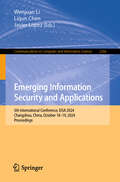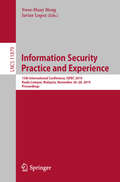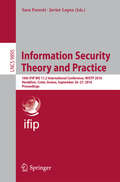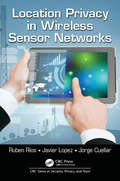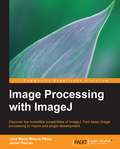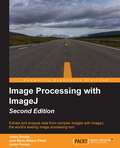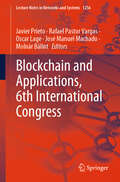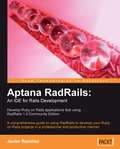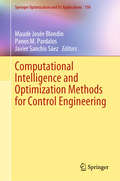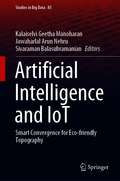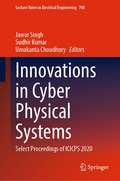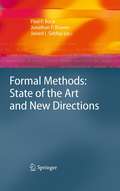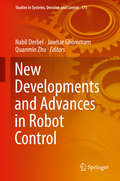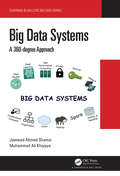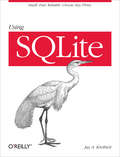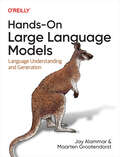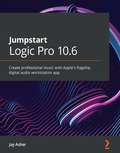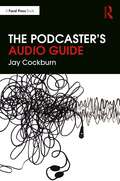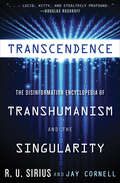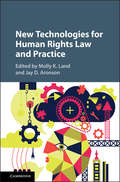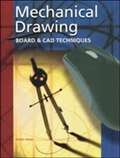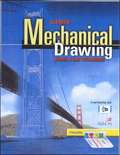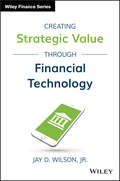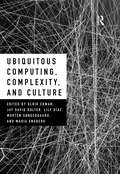- Table View
- List View
Emerging Information Security and Applications: 5th International Conference, EISA 2024, Changzhou, China, October 18–19, 2024, Proceedings (Communications in Computer and Information Science #2266)
by Liqun Chen Javier Lopez Wenjuan LiThis book constitutes the refereed proceedings of the 5th International Conference on EISA--Emerging Information Security and Applications, EISA 2024, held in Changzhou, China, during October 18–19, 2024. The 15 full papers and 3 short papers included in this book were carefully reviewed and selected from 52 submissions. The topics covered adversarial techniques, intrusions that may threaten the security of various assets, including information and applications, have become more complex.
Information Security Practice and Experience: 15th International Conference, ISPEC 2019, Kuala Lumpur, Malaysia, November 26–28, 2019, Proceedings (Lecture Notes in Computer Science #11879)
by Javier Lopez Swee-Huay HengThis book constitutes the refereed proceedings of the 15th International Conference on Information Security Practice and Experience, ISPEC 2019, held in Kuala Lumpur, Malaysia, in November 2019. The 21 full and 7 short papers presented in this volume were carefully reviewed and selected from 68 submissions. They were organized into the following topical sections: Cryptography I, System and Network Security, Security Protocol and Tool, Access Control and Authentication, Cryptography II, Data and User Privacy, Short Paper I, and Short Paper II.
Information Security Theory and Practice
by Javier Lopez Sara ForestiThis volume constitutes the refereed proceedings of the 10th IFIP WG 11. 2 International Conference on Information Security Theory and Practices, WISTP 2016, held in Heraklion, Crete, Greece, in September 2016. The 13 revised full papers and 5 short papers presented together in this book were carefully reviewed and selected from 29 submissions. WISTP 2016 sought original submissions from academia and industry presenting novel research on all theoretical and practical aspects of security and privacy, as well as experimental studies of fielded systems, the application of security technology, the implementation of systems, and lessons learned. The papers are organized in topical sections on authentication and key management; secure hardware systems; attacks to software and network systems; and access control and data protection.
Location Privacy in Wireless Sensor Networks (Series in Security, Privacy and Trust)
by Javier Lopez Jorge Cuellar Ruben RiosToday all kinds of ubiquitous systems, led by wireless sensor networks, can be seen as an unprecedented privacy risk given their ability to collect information on quantities and situations so far unsuspected. There is therefore an urgent need to develop mechanisms to ensure privacy in sensor networks. Location Privacy in Wireless Sensor Networks focuses on location privacy, by which an attacker might determine the source and destination of communications with simple techniques. This poses a serious threat as the attacker might use this information to reach the assets or individuals being monitored or even to destroy or compromise the whole network. This book will aid in the protection against this serious privacy threat.
Image Processing with ImageJ
by Javier Pascau Jose Maria Mateos-PerezThe book will help readers discover the various facilities of ImageJ through a tutorial-based approach.This book is targeted at scientists, engineers, technicians, and managers, and anyone who wishes to master ImageJ for image viewing, processing, and analysis. If you are a developer, you will be able to code your own routines after you have finished reading this book. No prior knowledge of ImageJ is expected.
Image Processing with ImageJ - Second Edition
by Javier Pascau Jurjen Broeke Jose Maria PerezExtract and analyze data from complex images with ImageJ, the world's leading image processing tool About This Book * Design automated image-processing solutions and speed up image-processing tasks with ImageJ * Create quality and intuitive interfaces for image processing by developing a basic framework for ImageJ plugins. * Tackle even the most sophisticated datasets and complex images Who This Book Is For The book has been created for engineers, scientists, and developers eager to tackle image processing with one of the leading tools available. No prior knowledge of ImageJ is needed. Familiarity with Java programming will be required for readers to code their own routines using ImageJ. What You Will Learn * Install and set up ImageJ for image processing. * Process images using ImageJ's built-in tools * Create macros to perform repetitive processing tasks * Set up and use an integrated development environment for ImageJ plugins * Create plugins with a user-friendly interface for processing * Use established ImageJ plugins for processing and quantification * Generate a simple interface based on a real world example and create other interfaces for other projects * Speed up interface development by setting multiple parameters interactively In Detail Advances in image processing have been vital for the scientific and technological communities, making it possible to analyze images in greater detail than ever before. But as images become larger and more complex, advanced processing techniques are required. ImageJ is built for the modern challenges of image processing - it's one of the key tools in its development, letting you automate basic tasks so you can focus on sophisticated, in depth analysis. This book demonstrates how to put ImageJ into practice. It outlines its key features and demonstrates how to create your own image processing applications using macros and ImageJ plugins. Once you've got to grips with the basics of ImageJ, you'll then discover how to build a number of different image processing solutions. From simple tasks to advanced and automated image processing, you'll gain confidence with this innovative and powerful tool - however and whatever you are using it for. Style and approach A step-by-step guide to image processing and developing macros and plugins in ImageJ. The book will progress from using the built-in tools to macros and finally plugins for image processing.
Blockchain and Applications, 6th International Congress (Lecture Notes in Networks and Systems #1256)
by Javier Prieto José Manuel Machado Rafael Pastor Vargas Oscar Lage Molnár BálintThis book compiles the proceedings of 6th International Congress on Blockchain and Applications 2024 (BLOCKCHAIN’24), held in Salamanca, Spain, in June 2024. The book includes 31 full papers presented in the main track that were selected among 51 submissions, highlighting theoretical advances and practical implementation of blockchain and distributed ledger technologies (DLTs). In addition, it contains 9 papers from the associated workshops and doctoral consortium that cover topics such as cybersecurity, legal aspects, and climate action. Blockchain and DLTs have revolutionized the scientific community by enabling breakthroughs in secure, decentralized data management, fostering transparency, and collaboration. Researchers are boosting innovation in areas like smart contracts, consensus algorithms, and governance models. In combination with cutting-edge technologies such as AI, metaverse, or quantum computing, blockchain and DLTs are shaping the future of digital trust and innovation.
Aptana RadRails: An IDE for Rails Development
by Javier RamirezThis book is for Ruby on Rails developers who want to make the most of the framework by using an Integrated Development Environment. Even though the book explains everything you need to follow the contents, the focus is on how to use the tool and not on the Rails framework itself, so previous working knowledge of Rails is highly advisable. Previous knowledge of Eclipse is not necessary.
Computational Intelligence and Optimization Methods for Control Engineering (Springer Optimization and Its Applications #150)
by Panos M. Pardalos Maude Josée Blondin Javier Sanchis SáezThis volume presents some recent and principal developments related to computational intelligence and optimization methods in control. Theoretical aspects and practical applications of control engineering are covered by 14 self-contained contributions. Additional gems include the discussion of future directions and research perspectives designed to add to the reader’s understanding of both the challenges faced in control engineering and the insights into the developing of new techniques. With the knowledge obtained, readers are encouraged to determine the appropriate control method for specific applications.
Artificial Intelligence and IoT: Smart Convergence for Eco-friendly Topography (Studies in Big Data #85)
by Kalaiselvi Geetha Manoharan Jawaharlal Arun Nehru Sivaraman BalasubramanianThis book projects a futuristic scenario that is more existent than they have been at any time earlier. To be conscious of the bursting prospective of IoT, it has to be amalgamated with AI technologies. Predictive and advanced analysis can be made based on the data collected, discovered and analyzed. To achieve all these compatibility, complexity, legal and ethical issues arise due to automation of connected components and gadgets of widespread companies across the globe. While these are a few examples of issues, the authors’ intention in editing this book is to offer concepts of integrating AI with IoT in a precise and clear manner to the research community. In editing this book, the authors’ attempt is to provide novel advances and applications to address the challenge of continually discovering patterns for IoT by covering various aspects of implementing AI techniques to make IoT solutions smarter. The only way to remain pace with this data generated by the IoT and acquire the concealed acquaintance it encloses is to employ AI as the eventual catalyst for IoT. IoT together with AI is more than an inclination or existence; it will develop into a paradigm. It helps those researchers who have an interest in this field to keep insight into different concepts and their importance for applications in real life. This has been done to make the edited book more flexible and to stimulate further interest in topics. All these motivated the authors toward integrating AI in achieving smarter IoT. The authors believe that their effort can make this collection interesting and highly attract the student pursuing pre-research, research and even master in multidisciplinary domain.
Innovations in Cyber Physical Systems: Select Proceedings of ICICPS 2020 (Lecture Notes in Electrical Engineering #788)
by Jawar Singh Umakanta Choudhury Sudhir KumarThe book presents a collection of peer-reviewed articles from the International Conference on Innovations in Cyber Physical Systems (ICICPS 2020). The conference provided opportunities for the presentation of new research results and discussion about them. It was also an opportunity to generation of new ideas in all CPS aspects, including theory, tools, applications, systems, test-beds and field deployments. The range of topics explored is wide, and covers security, control, optimization, machine learning, game theory, mechanism design, mobile and cloud computing, model-based design, verification, data mining/analytics, signal processing, and human-in-the-loop shared or supervisory control. This book will be useful to researchers, students, industrialist, developers, and practitioners alike.
Formal Methods: State of the Art and New Directions
by Jawed Siddiqi Paul Boca Jonathan P. BowenThe last decade has witnessed a modest but sustained increase in researching and applying formal methods. A number of well cited success stories are now available and provide strong evidence that formal methods can be effective and deployed in industrial-scale applications. Through fundamental contributions from leading researchers, this book provides further evidence of the use of formal methods in the areas of requirements, design, modelling and implementation, verification and validation. The self-contained chapters are views from experts in these areas, providing readers with rich background information and a diverse breadth of specialist material. This authoritative collection of views provides a snapshot of the field and will be of considerable interest to researchers and professionals seeking a perspective on fundamental underpinnings of formal methods and current hot topics in the field. The following website www.fmsand.info is associated with the book.
New Developments and Advances in Robot Control (Studies in Systems, Decision and Control #175)
by Quanmin Zhu Nabil Derbel Jawhar GhommamThis book highlights relevant studies and applications in the area of robotics, which reflect the latest research, from interdisciplinary theoretical studies and computational algorithm development, to representative applications. It presents chapters on advanced control, such as fuzzy, neural, backstepping, sliding mode, adaptive, predictive, diagnosis and fault tolerant control etc. and addresses topics including cloud robotics, cable-driven robots, two-wheeled robots, mobile robots, swarm robots, hybrid vehicle, and drones. Each chapter employs a uniform structure: background, motivation, quantitative development (equations), case studies/illustration/tutorial (simulations, experiences, curves, tables, etc.), allowing readers to easily tailor the techniques to their own applications.
Big Data Systems: A 360-degree Approach
by Jawwad Ahmad ShamsiBig Data Systems encompass massive challenges related to data diversity, storage mechanisms, and requirements of massive computational power. Further, capabilities of big data systems also vary with respect to type of problems. For instance, distributed memory systems are not recommended for iterative algorithms. Similarly, variations in big data systems also exist related to consistency and fault tolerance. The purpose of this book is to provide a detailed explanation of big data systems. The book covers various topics including Networking, Security, Privacy, Storage, Computation, Cloud Computing, NoSQL and NewSQL systems, High Performance Computing, and Deep Learning. An illustrative and practical approach has been adopted in which theoretical topics have been aided by well-explained programming and illustrative examples. Key Features: Introduces concepts and evolution of Big Data technology. Illustrates examples for thorough understanding. Contains programming examples for hands on development. Explains a variety of topics including NoSQL Systems, NewSQL systems, Security, Privacy, Networking, Cloud, High Performance Computing, and Deep Learning. Exemplifies widely used big data technologies such as Hadoop and Spark. Includes discussion on case studies and open issues. Provides end of chapter questions for enhanced learning.
Using SQLite: Small. Fast. Reliable. Choose Any Three. (O'reilly Ser.)
by Jay A. KreibichApplication developers, take note: databases aren't just for the IS group any more. You can build database-backed applications for the desktop, Web, embedded systems, or operating systems without linking to heavy-duty client-server databases such as Oracle and MySQL. This book shows you how to use SQLite, a small and lightweight relational database engine that you can build directly into your application.With SQLite, you'll discover how to develop a database-backed application that remains manageable in size and complexity. This book guides you every step of the way. You'll get a crash course in data modeling, become familiar with SQLite's dialect of the SQL database language, and much more.Learn how to maintain localized storage in a single file that requires no configurationBuild your own SQLite library or use a precompiled distribution in your applicationGet a primer on SQL, and learn how to use several language functions and extensionsWork with SQLite using a scripting language or a C-based language such as C# or Objective-CUnderstand the basics of database design, and learn how to transfer what you already know to SQLiteTake advantage of virtual tables and modules"Complex SQL concepts explained clearly."--D. Richard Hipp, creator of SQLite
Hands-On Large Language Models: Language Understanding and Generation
by Jay Alammar Maarten GrootendorstAI has acquired startling new language capabilities in just the past few years. Driven by the rapid advances in deep learning, language AI systems are able to write and understand text better than ever before. This trend enables the rise of new features, products, and entire industries. With this book, Python developers will learn the practical tools and concepts they need to use these capabilities today.You'll learn how to use the power of pre-trained large language models for use cases like copywriting and summarization; create semantic search systems that go beyond keyword matching; build systems that classify and cluster text to enable scalable understanding of large amounts of text documents; and use existing libraries and pre-trained models for text classification, search, and clusterings.This book also shows you how to:Build advanced LLM pipelines to cluster text documents and explore the topics they belong toBuild semantic search engines that go beyond keyword search with methods like dense retrieval and rerankersLearn various use cases where these models can provide valueUnderstand the architecture of underlying Transformer models like BERT and GPTGet a deeper understanding of how LLMs are trainedUnderstanding how different methods of fine-tuning optimize LLMs for specific applications (generative model fine-tuning, contrastive fine-tuning, in-context learning, etc.)
Jumpstart Logic Pro X 10.5: Create professional music with Apple's flagship digital audio workstation app
by Jay AsherA practical guide that takes you from understanding the fundamentals of Logic Pro X to discovering professional music creation techniques with an easy-to-follow approachKey FeaturesExplore the world of music production by getting up to speed with Logic Pro XUnderstand the fundamentals of music production such as recording, editing, and adding effects to musicLearn to produce virtual sounds and music effects to enhance your music and create a final master from a raw music fileBook DescriptionLogic Pro X is Apple's flagship application for music creation, found in many professional music studios across the globe. It is a powerful digital audio workstation that comes with all the software tools that you need to create music that sounds great. In the latest version, Logic Pro X 10.5, Apple has added impressive features to what was already a full package of tools, loops, FX plug-ins, and software instruments.Providing a comprehensive introduction if you're new to Mac computer music creation, this practical guide will show you how to use Logic Pro X and have you up to speed in no time.You'll not only understand what Apple's Logic Pro X software can do but also get hands-on with using it to accomplish various musical tasks. The book starts by getting you up and running with the basic terminologies. As you progress, you'll explore how to create audio and MIDI musical parts. To build on your knowledge further, the book will guide you through developing an automated mix. In addition to this, you'll learn how to bounce mixes and audio files for distribution.By the end of this book, you'll be well-versed with Logic Pro X and have the skills you need to create professional-quality music.What you will learnGet to grips with Audio and MIDI and how they are different, along with covering Apple LoopsRecord and edit audio, such as your voice or guitarCreate and edit MIDI parts, using Logic Pro X's software instrumentsDevelop realistic drums and electronic drums with Logic Pro X 10.5's amazing DrummerExplore the new Step Sequencer, Live Loops, and Quick Sampler that are now included with version 10.5Edit your arrangement and prepare the parts for mixingDiscover the principles of good mixing, including automation, pre-mastering, and final bouncingWho this book is forThis book is for musicians, songwriters, and music producers who want to learn Logic Pro X from scratch with the help of expert guidance. A basic understanding of music theories such as chords and notes is highly recommended before you get started. This Logic Pro X book also assumes that you'll be working on a Mac.
The Podcaster's Audio Guide
by Jay CockburnThe Podcaster's Audio Guide is a concise introduction to simple sound engineering techniques for podcasters. This digestible guide explains the basics of audio engineering, from equipment, to recording, editing, mixing and publishing. Suitable for beginners from all backgrounds, including students and hobbyists, as well as professional content producers looking to experiment with podcasts, The Podcaster's Audio Guide is the perfect resource with cheat sheets, starting set-ups and a comprehensive jargon buster.
Transcendence: The Disinformation Encyclopedia of Transhumanism and the Singularity
by R.U. Sirius Jay Cornell&“A deceptively light treatment of mind-blowing technologies and their cultural, social and political impact. This book will put your mind on fire.&”—Giulio Prisco, Hacked.com Transhumanism is an international movement that advocates the use of science and technology to overcome the natural limitations experienced by humanity, through such developments as: the Singularity—the creation of machine intelligences that exceed the capacities of our biological brainsthe ability to replicate individual minds and put them into solid-state bodies or virtual environmentsindividual control over mental and emotional states for enhancing functionalities and/or ecstasies Some of this is happening now. Some it is still in the minds of dreamers. In nearly ninety A-Z entries, Transcendence provides a multilayered look at the accelerating advances in artificial intelligence, cognitive science, genomics, information technology, nanotechnology, neuroscience, space exploration, synthetic biology, robotics, and virtual worlds that are making transhumanism a reality. Entries range from Cloning and Cyborg Feminism to Designer Babies and Memory-Editing Drugs. In addition, the book notes historical predecessors and personalities, both in mythology and history—ranging from Timothy Leary to Michael Jackson to Ray Kurzweil. It also introduces the culture around Transhumanism, covering all the geeky obsessions of the Transhumanist movement. &“A new book deciphering the surreal truths, questionable fictions, and high weirdness of the Singularity . . . Infotaining, irreverent, and frequent piss-taking paperback.&”—Boing Boing &“RU Sirius and Jay Cornell present us with their own psychedelic guide to the galaxy in this adventurous idea-rich book, bootstrapping on emerging technologies that beckon us to take control of our evolutionary destiny and lead humanity towards radical new landscapes of mind, of dream, of cosmos, of possibility.&”—Jason SilvaTranshumanism is an international movement that advocates the use of science and technology to overcome the natural limitations experienced by humanity, through such developments as:the Singularitythe creation of machine intelligences that exceed the capacities of our biological brainsthe ability to replicate individual minds and put them into solid-state bodies or virtual environmentsindividual control over mental and emotional states for enhancing functionalities and/or ecstasiesSome of this is happening now. Some it is still in the minds of dreamers. In nearly ninety A-Z entries,Transcendenceprovides a multilayered look at the accelerating advances in artificial intelligence, cognitive science, genomics, information technology, nanotechnology, neuroscience, space exploration, synthetic biology, robotics, and virtual worlds that are making transhumanism a reality. Entries range from Cloning and Cyborg Feminism to Designer Babies and Memory-Editing Drugs. In addition, the book notes historical predecessors and personalities, both in mythology and historyranging from Timothy Leary to Michael Jackson to Ray Kurzweil. It also introduces the culture around Transhumanism, covering all the geeky obsessions of the Transhumanist movement.
New Technologies for Human Rights Law and Practice
by Jay D. Aronson Molly K. LandNew technological innovations offer significant opportunities to promote and protect human rights. At the same time, they also pose undeniable risks. In some areas, they may even be changing what we mean by human rights. The fact that new technologies are often privately controlled raises further questions about accountability and transparency and the role of human rights in regulating these actors. This volume – edited by Molly K. Land and Jay D. Aronson – provides an essential roadmap for understanding the relationship between technology and human rights law and practice. It offers cutting-edge analysis and practical strategies in contexts as diverse as autonomous lethal weapons, climate change technology, the Internet and social media, and water meters. This title is also available as Open Access.
Mechanical Drawing Board and CAD Techniques (13th Edition)
by Thomas E. French Jay D. HelselThis completely revised comprehensive drafting book for high school includes solid drafting instruction, board drafting techniques, and computer aided drafting techniques. Each chapter provides a large number of practice problems, "Tech Math" incorporating math skills needed for the covered topics, and "Success on the Job" employability skills needed on the job.
Mechanical Drawing: Board & CAD Techniques
by Jay D. HelselProject-based learning prepares students for professional certification with Glencoe Mechanical Drawing: Board and CAD Techniques! Endorsed by the American Design Drafting Association (ADDA), this text includes Prep for ADDA activities. Step-by-step applications, design problems, and drafting problems prepare students for professional excellence and certification. Project-based learning is supported with unit-based projects that integrate technical math and culminate in Build Your Portfolio activities. Help your students get ready for competitive events like the TSA and SkillsUSA with prep activities embedded throughout the content and end-of-chapter assessments. Rigorous academic content is supported, with a special emphasis on math, geometry, and science, with STEM activities. Point-of-use correlations ease possible academic credit application. Extra activities in the Student Edition and workbook help you meet Perkins mandates. The appendix features Math (including algebra and geometry), abbreviations and symbols, pipe symbols, and reference tables (ASME, ANSI, ISO).
Creating Strategic Value through Financial Technology
by Jay D. Wilson Jr.Lessons in innovation from key FinTech trends and successes Creating Strategic Value through Financial Technology explores the growing Financial Technology (FinTech) industry to provide insight on how traditional financial institutions and FinTech companies can boost innovation and enhance valuation in a complex regulatory environment. In plumbing the depth and breadth of several niches within in the FinTech sector, author Jay Wilson uncovers key themes that have contributed to the industry's success; in this book, he maps them together to provide useful guideposts for investors, entrepreneurs, and traditional institutions looking to facilitate growth as technology and financial services collide. With an expert's perspective on FinTech history and outlook, certain trends and examples of value-enhancing strategies stand out. FinTech niches covered include: payments, crowdfunding, alternative/marketplace lending, the blockchain, and technology solutions in the context of banking, insurance, and investment companies. There is no denying the growing importance of technology in the financial services industry, and the FinTech sector offers valuable solutions for a diverse array of financial services providers and their customers. This book guides you through several niches of the FinTech sector, and highlights the most important takeaways from recent endeavors. Navigate the financial technology sector Enhance customer and product offerings Improve efficiency and cost structure Enhance profitability and company valuation from the intersection of technology and finance Innovation and customer preference is a key driver of FinTech's growth. Customers are demanding better value and convenience, and the organizations that provide it are reaping the rewards of growth. As financial regulations grow more and more complex, and customers are presented with more and more options, it is becoming imperative for traditional institutions to modernize processes and carve out a place in the future of financial services. Creating Strategic Value through Financial Technology provides a handbook for navigating that space, with practical guidance on how FinTech companies and traditional financial institutions can enhance profitability and valuation from the trends.
Ubiquitous Computing, Complexity and Culture
by Jay David Bolter Ulrik Ekman Lily Diaz Morten Sondergaard Maria EngbergThe ubiquitous nature of mobile and pervasive computing has begun to reshape and complicate our notions of space, time, and identity. In this collection, over thirty internationally recognized contributors reflect on ubiquitous computing’s implications for the ways in which we interact with our environments, experience time, and develop identities individually and socially. Interviews with working media artists lend further perspectives on these cultural transformations. Drawing on cultural theory, new media art studies, human-computer interaction theory, and software studies, this cutting-edge book critically unpacks the complex ubiquity-effects confronting us every day. The companion website can be found here: http://ubiquity.dk
Writing Space: Computers, Hypertext and the Remediation of Print (2nd edition)
by Jay David BolterWhen Bolter (Georgia Institute of Technology) finished the first edition in the early 1990s, the World Wide Web was only a couple years old and was still used primarily by research centers and universities. Changes in the technology, the use of it, and the perception of it has convinced him to shift the focus of the second edition to show how hypertext and other forms of electronic writing refashion the forms and genres of print.
